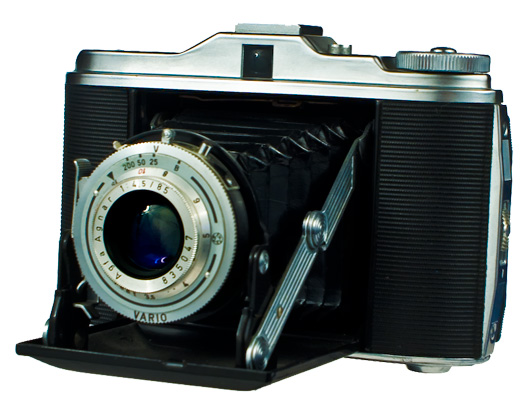
Approx. dates of manufacture: 1950 – 1952
Approx. street value: very low
ANSCO was an American firm that began in the early 20th century as the merger between Anthony, Scoville and other companies. In 1928 they were purchased by another acronym, AGFA. They were AGFA-ANSCO through the 1930s but World War II made them low-key the German connection; they became just Ansco until the mid-1960s when they changed to GAF, and struggled along another decade until they pulled out of the amateur market altogether.
The Speedex line can be a bit confusing. Ansco made Speedex cameras in the USA for awhile; later they were imported from Germany (mine is German, hence the flag on this page). Agfa made the same cameras for the European market but called them Isolettes.
I believe my particular camera is an Isolette V that was badged as Speedex for the American market. Other Isolette models are analogous various Speedex models.
What happened to the American version? I don't know; my belief (unencumbered by actual evidence) is that US import duties probably did not apply to parts; so Ansco imported and fitted the German-made lens and shutter assembly onto the American-made body. When the duties were relaxed, Ansco dropped production and imported the whole german-made camera for sale in the US. Co-branding, prior to the 1950s, used to be more common. Weston used to made light meters in the USA for the domestic market, and Sangamo-Weston made the same meters in England for Europe. When tax laws changed, American Weston imported meters directly from England and sold them in the USA.
There were a number of Speedex/Isolettes. This was the base model: fixed-mount lens on a self-erecting folding platform (self-erecting means it folds and pops into place automatically as the door opens and closes); a shutter with few speeds; a so-so lens. No shutter-button on the body (later models had it), you push a little vertical tab that's mounted on the side of the shutter; no double-exposure protection; manual shutter cock; film advance by knob on the top and counter by an unprotected ruby window on the back. No meter. No rangefinder. They did mount an accessory shoe on top of the viewfinder if you wanted to add a clip-on meter, rangefinder or flash. It does have a flash sync recepticle.
Various models or variants came with different lens and shuttter combinations; mine is the least expensive and likely most common 85mm ƒ/4.5 Agnar in a Vario shutter. The Agnar gets decent reviews from what I read on Photo.net. The Vario shutter was made by Gauthier, the same people who make the Prontor line. Varios were the low end, Prontos and Prontors were middle-class. The high-end shutters were made by Deckel and called Compurs. Both Gauthier and Deckel were owned by Zeiss Ikon. You can find Speedex cameras with all three shutters.
My Vario shutter has three speeds: 200, 50, and 25; note the two-stop difference between 250 and 50, but only one stop between 50 and 25; gotta remember that when you're making adjustments. The aperture stops are marked in full-stop increments from ƒ/32 to ƒ/5.6, then you hit ƒ/4.5.
The focusing ring is calibrated in feet, but there is no depth-of-field scale. If you want to maximize DOF, you'll need a chart.
Interesting camera. Purchased for $13 from a thrift shop. First thing I thought of when I opened it up was that was basically a smaller Billy (which also has an Agnar lens in a Vario shutter). The Billy is a larger body and makes a larger image, and it's all black so it fits in with the visual designs of pre-war folders. This Speedex has a silver top and bottom, and looks much newer and more like other 1950s and 60s cameras. The 2-¼ square format makes it a bit smaller, so it fits easier to a pocket or purse. I believe it was also more commonly found in a neverready case, as it lacks the Billy's little strap handle.
Will I ever use it? Probably not. Considering the current outrageous price of film ($6 a roll for B&W negative, without processing, as of 2022), I've got other cameras I'd much rather use first.
Camera manual: Orphan Cameras.com

